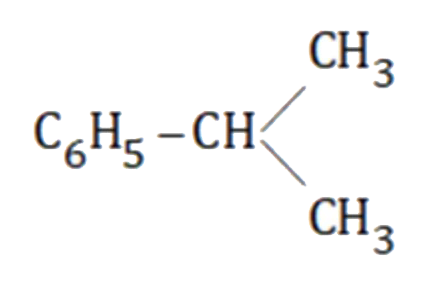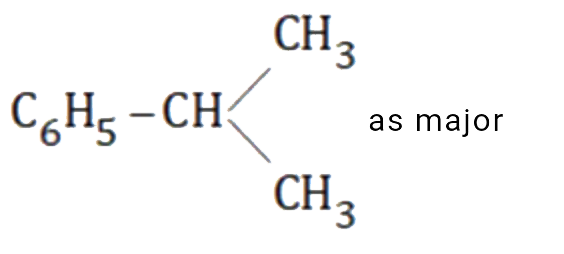The products of the reaction will be
C6H6+CH3−CH2−CH2−BrAnhy.AlBr3−−−−−−→
C6H5−CH2−CH2−CH3

 as major product and C6H5−CH2−CH2−CH3 as minor product.
as major product and C6H5−CH2−CH2−CH3 as minor product.
1 : 1 mixture of C6H5−CH2−CH2−CH3 and 
The correct Answer is:C
To solve the given problem, we will analyze the reaction between benzene and n-propyl bromide in the presence of anhydrous aluminum bromide (AlBr₃). This reaction is a Friedel-Crafts alkylation, which involves the formation of a carbocation that can react with benzene.
1. Identify the Reactants:
- The reactants are benzene (C₆H₆) and n-propyl bromide (C₃H₇Br).
2. Understand the Role of Aluminum Bromide:
- Anhydrous aluminum bromide (AlBr₃) acts as a Lewis acid and helps in generating a more reactive species from n-propyl bromide.
3. Formation of Carbocation:
- When n-propyl bromide reacts with AlBr₃, it forms a carbocation. The reaction can be represented as:
C3H7Br+AlBr3→C3H+7+AlBr−4
- The n-propyl carbocation (C₃H₇⁺) is a primary carbocation.
4. Carbocation Rearrangement:
- Primary carbocations can rearrange to form more stable secondary carbocations. In this case, the n-propyl carbocation can undergo a hydride shift to become a more stable isopropyl carbocation:
C3H+7→C3H+7 (isopropyl)
5. Electrophilic Attack on Benzene:
- The more stable isopropyl carbocation can then react with benzene. The electrophilic aromatic substitution occurs, leading to the formation of isopropylbenzene (also known as cumene):
C6H6+C3H+7→C6H5C(CH3)2
6. Minor Product Formation:
- Although the major product is isopropylbenzene, some n-propylbenzene will also be formed from the original n-propyl carbocation without rearrangement:
C6H6+C3H+7→C6H5C3H7
7. Final Products:
- The final products of the reaction are:
- Major Product: Isopropylbenzene (C₆H₅C(CH₃)₂)
- Minor Product: n-Propylbenzene (C₆H₅C₃H₇)
Conclusion:
The products of the reaction are isopropylbenzene (major product) and n-propylbenzene (minor product).
- The reactants are benzene (C₆H₆) and n-propyl bromide (C₃H₇Br).
- Anhydrous aluminum bromide (AlBr₃) acts as a Lewis acid and helps in generating a more reactive species from n-propyl bromide.
- When n-propyl bromide reacts with AlBr₃, it forms a carbocation. The reaction can be represented as:
C3H7Br+AlBr3→C3H+7+AlBr−4
- The n-propyl carbocation (C₃H₇⁺) is a primary carbocation.
- Primary carbocations can rearrange to form more stable secondary carbocations. In this case, the n-propyl carbocation can undergo a hydride shift to become a more stable isopropyl carbocation:
C3H+7→C3H+7 (isopropyl)
- The more stable isopropyl carbocation can then react with benzene. The electrophilic aromatic substitution occurs, leading to the formation of isopropylbenzene (also known as cumene):
C6H6+C3H+7→C6H5C(CH3)2
- Although the major product is isopropylbenzene, some n-propylbenzene will also be formed from the original n-propyl carbocation without rearrangement:
C6H6+C3H+7→C6H5C3H7
- The final products of the reaction are:
- Major Product: Isopropylbenzene (C₆H₅C(CH₃)₂)
- Minor Product: n-Propylbenzene (C₆H₅C₃H₇)
The products of the reaction are isopropylbenzene (major product) and n-propylbenzene (minor product).
Similar Questions
What will be product in the following reaction
CH3−CH2−CH2−CH3KMnO4−−−−→?
View SolutionWrite structures of the products of the following reactions:
(i) CH3−CH=CH2H2O/H+−−−−−→
(ii)
(iii) CH3−CH2−C | CH3H−CHONaBH4−−−−→
View SolutionIn the given reaction CH3−CH2−CH2−O−CH2−CH3Conc.Hl−−−−→(X)+(Y)
View SolutionFor the reaction C6H6+(CH3)2CHCH2ClAnhy.AlCl3−−−−−−→ The final product is
View SolutionCH3CH2−O−CH3anhyHI−−−−→? Product is
View SolutionThe major product of the following reaction is :
(CH3)2C=CH−CH2−CH3(i)B2H6,ether(ii)H2O2,NaOH−−−−−−−−−−−−−−−−−−−−→
View SolutionThe end product of the following reaction
CH3MgBr+CH2=CH−CHOH3O+−−−→ is :
View SolutionProduct of the given reaction CH3CH2−CH=CH3SiO2−−→ will be
View SolutionC6H5CHO+CH3CH2CHOdil.NaOH−−−−−→
View SolutionThe product of the reaction
 CHO+(C6H5−CHCO)2OC6H5−CH2COONa/Δ−−−−−−−−−−−−−−→(X) will be
CHO+(C6H5−CHCO)2OC6H5−CH2COONa/Δ−−−−−−−−−−−−−−→(X) will be
View Solution
